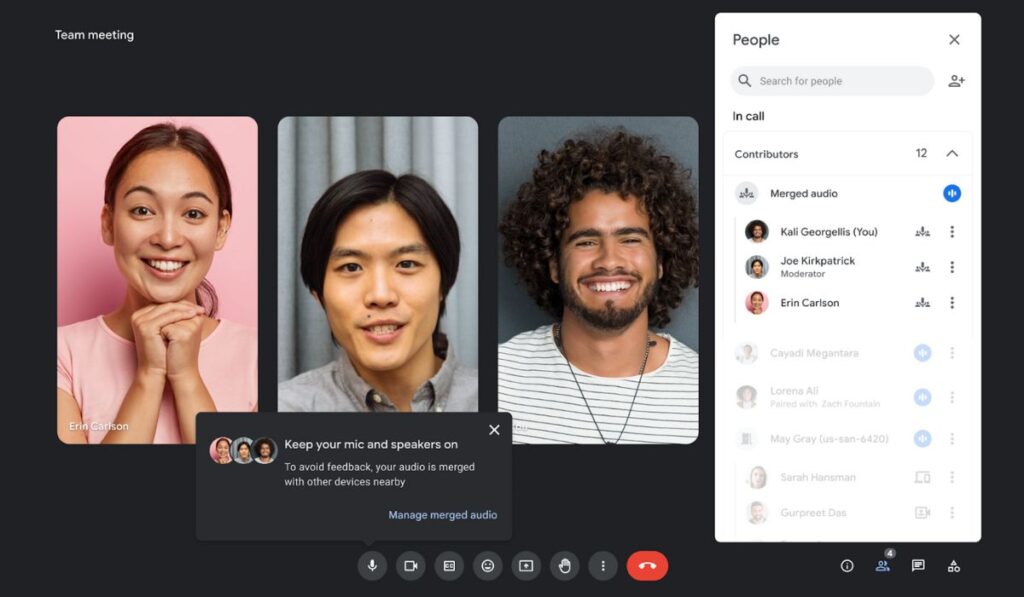Google Meet Gets Smarter: Adaptive Audio Enhances Remote Meetings with Multi-Laptop Synergy

Remote work has become the norm for many, and crystal-clear audio remains paramount for productive online meetings. While dedicated conferencing equipment delivers exceptional results, it’s not always accessible. Google Meet’s innovative solution, adaptive audio, is here to bridge the gap. Let’s delve into how this feature transforms your remote meetings by leveraging the power of multiple laptops.
What is Google Meet’s Adaptive Audio?
Adaptive audio is a groundbreaking feature that utilizes artificial intelligence to elevate the audio quality of your Google Meet sessions. It automatically detects multiple laptops in the same meeting space and intelligently merges their microphones and speakers. This eliminates the need for participants to huddle around a single device, promoting a more natural meeting experience.
Benefits of Adaptive Audio
The advantages of Google Meet’s adaptive audio are numerous, making it a game-changer for remote teams:
- Enhanced Audio Clarity: By combining the microphones of multiple laptops, adaptive audio captures a broader soundstage. This reduces the reliance on a single microphone, minimizing the possibility of muffled voices or audio dropouts, especially if participants are spread out in a larger room.
- Reduced Echo and Feedback: Echo and feedback can be disruptive and frustrating during online meetings. Adaptive audio tackles this issue by intelligently processing the audio streams from various laptops. This minimizes the chance of microphone pickup from nearby speakers, ensuring a smooth and uninterrupted flow of conversation.
- Flexibility in Meeting Locations: Say goodbye to limitations! With adaptive audio, teams can now hold productive meetings in unconventional spaces like cafes, lounges, or even open work areas. This newfound flexibility fosters collaboration and spontaneous brainstorming sessions without worrying about subpar audio quality.
- Cost-Effective Solution: Dedicated video conferencing equipment can be expensive. Adaptive audio offers a cost-effective alternative, particularly for small businesses and startups. By leveraging existing laptops, teams can experience significant improvements in audio quality without significant investment.
- Improved Accessibility: Not everyone has access to high-end microphones. Adaptive audio levels the playing field by utilizing the built-in microphones on multiple laptops. This ensures everyone can be heard clearly, regardless of their individual equipment setup.
Who Can Use Adaptive Audio?
Currently, adaptive audio is rolling out to Google Workspace customers with specific plans, including Gemini Enterprise, Gemini Business, Gemini Education, Gemini Education Premium, and the AI Meetings and Messaging add-on. It’s expected to become more widely available in the coming months.
How Does Adaptive Audio Work?

The technical aspects of adaptive audio are quite impressive. Here’s a simplified breakdown:
- Device Detection: As participants join a Google Meet session, adaptive audio automatically identifies multiple laptops within the same meeting space.
- Audio Stream Merging: The audio streams from each laptop’s microphone are intelligently combined. Google’s AI algorithms likely factor in factors like distance from the speaker and background noise levels to optimize the final audio mix.
- Speaker Selection: The system automatically selects the optimal speaker based on the combined audio stream. This ensures all participants hear the meeting audio clearly.
- Echo Cancellation: Adaptive audio employs sophisticated echo cancellation techniques to eliminate any potential audio feedback caused by microphone pickup from nearby speakers.
Is Adaptive Audio Right for You?
If you and your team frequently conduct remote meetings and are looking to elevate your audio experience, adaptive audio is a compelling solution. Here are some additional factors to consider:
- Workspace Plan: Ensure your Google Workspace plan includes access to the AI features that enable adaptive audio.
- Meeting Size and Location: Adaptive audio is particularly beneficial for smaller teams meeting in non-traditional conference rooms, where microphone placement and room acoustics can pose challenges.
The Future of Audio in Remote Meetings
Adaptive audio represents a significant step forward for Google Meet and the future of remote work. By leveraging the power of AI and existing hardware, it paves the way for more natural, seamless, and inclusive online meetings. As technology continues to evolve, we can expect even more intelligent features that further enhance the remote collaboration experience.


